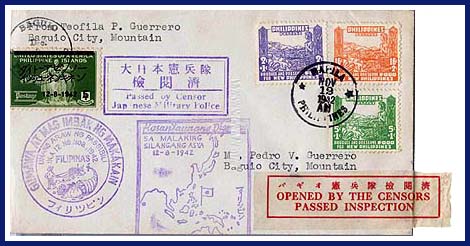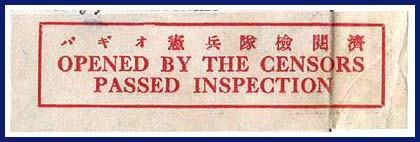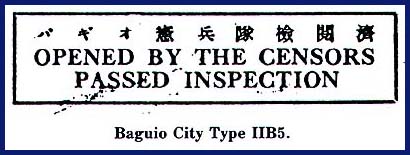

CENSOR
LABEL ON FOOD PRODUCTION CAMPAIGN FDC
November
12, 1942
Garrett Type
IIB5 gummed label, described on page 156 of A Postal History of the Japanese
Occupation of the Philippines, 1942 - 1945, as follows:
Size:
Frame lines, 69 x 11.5 mm.
Overall, 80
x 23 mm.
Color: Red
printing on very white paper.
Earliest known
use: (Unknown)
Translation:
Left to right, three katakana, "Bagio"; six kanji,
"Kempeitai
Ken'etsn zurni" or "Censored by Military Police Corps."
|

Garrett Illustration
Garrett states:
"The
example illustrated was found on a fraudulent cover prepared subsequent
to the Japanese Occupation. Examples used on genuine Baguio City covers
have been reliably reported, but none has been available for inspection."
The cover is from
Ray Coughlin with the following note:
Page
156, Baguio censor label. His illustrations are somewhat blurry
when it comes to the Japanese characters. Note the lettering
and the Japanese characters are the same size on this label as his.
The difference is that the frame line on this label measures 79x24mm.
The paper is not a very white paper, but rather an off white paper.
The paper is quite thin as are most of these labels I have seen and
the gum was readily loosened to lift the edge of the label, which is
typical of the other labels I have seen. Is it possible that we have
counterfeit in the book, as the break at the top lines are similar.
The printing on this is much clearer on the Japanese writing which
would indicate that it was actually done under their auspices.
Or is it possible the type was reused on Gene's or my copy with a
different frame line placed on the plate which produced them.
A printer would be more likely to keep the type set for further use
as the frames are easily added to a plate as compared to the typesetting,
or is it possible that the frames vary on the plate according to
the mood of the typesetter?
Ray adds:
I
think the seal was placed on the cover by "favor" to the sender, obviously
a collector. The cover still has full OG on the flap and was never
sealed, thus making it easier for a censor to actually examine it.
I think the seal is OK, but a different one than Gene Listed. The
label was folded around the end of the envelope, I soaked the back end
off to be able to fully illustrate it.
Your opinions
are solicited.
Best Regards,
Ray
Comments: Even
if philatelic, still a beautiful cover. This one I consider as one of the
rarities of the Japanese Occupation period. If someone out there has a
cover with this label attached, please be kind enough to share it with
us. Another label will certainly put to rest some questions on the label
form. |
|


